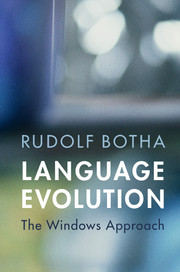Book contents
- Frontmatter
- Contents
- List of figures
- Acknowledgements
- Part I Preliminaries
- Part II Correlate windows
- Part III Analogue windows
- 5 Incipient pidgins and creoles
- 6 Homesign systems and emergent sign languages
- 7 Modern motherese
- 8 Hunter-gatherers’ use of language
- 9 Language acquisition
- Part IV Abduction windows
- Part V Epilogue
- Notes
- References
- Index
8 - Hunter-gatherers’ use of language
from Part III - Analogue windows
Published online by Cambridge University Press: 05 March 2016
- Frontmatter
- Contents
- List of figures
- Acknowledgements
- Part I Preliminaries
- Part II Correlate windows
- Part III Analogue windows
- 5 Incipient pidgins and creoles
- 6 Homesign systems and emergent sign languages
- 7 Modern motherese
- 8 Hunter-gatherers’ use of language
- 9 Language acquisition
- Part IV Abduction windows
- Part V Epilogue
- Notes
- References
- Index
Summary
Enter the !Kung
As noted in Section 7.5, the behaviour of contemporary hunter-gatherer mothers has been used by Dean Falk (2004: 499) for modelling the way in which early hominin mothers may have cared for their infants. Facets of the linguistic behaviour of contemporary hunter-gatherers and other people living in non-industrialised societies have likewise been used as a window on the evolution of language. This has been done recently by Katharine MacDonald and Wil Roebroeks (2013) in their study of the linguistic capacities of Neanderthals and other earlier hominins. They proceed from the view that attempts to draw inferences about these capacities from data in the archaeological record have to date been unsuccessful. So, they consider it necessary to develop ‘other ways of entry into the topic’. And they (2013: 98), accordingly, propose to take Neanderthals’ accomplishments in hunting large animals as such a way of entry. Proceeding from the assumption that efficient forms of communication and of knowledge transfer by teaching lay at the root of Pleistocene hunting skills, MacDonald and Roebroeks address the question whether the same holds good for Neanderthals. In response to this question, they argue as follows:
MacDonald and Roebroeks's line of argument
We cannot, obviously, study whether that was the case for Neanderthals, but we can study the way and contexts in which communication enhances foraging efficiency among extant hunter-gatherers whose traditional subsistence practices must be in many ways comparable to those of the Neanderthals (MacDonald 2007). (MacDonald and Roebroeks 2013: 98)
Pursuing this line of argument, MacDonald and Roebroeks review a considerable body of ethnographic work on the role of verbal instruction in the acquisition of hunting skills by children of modern hunter-gatherers such as the !Kung. That role, they believe, is likely to be suggestive of the role played by linguistic communication in Neanderthal transfer of information about animal behaviour.
In a second recent study, Maggie Tallerman (2013a) adopts a similar approach to getting a handle on the use of (proto)language by early hominins such as Homo erectus. At issue in her study is the tenability of proposals to the effect that the evolution of (proto)language was driven by interactions between closely related individuals, mothers and infants among them. In appraising these proposals, she is confronted with the problem of the lack of direct evidence about early hominin lifestyles.
Information
- Type
- Chapter
- Information
- Language EvolutionThe Windows Approach, pp. 139 - 160Publisher: Cambridge University PressPrint publication year: 2016
